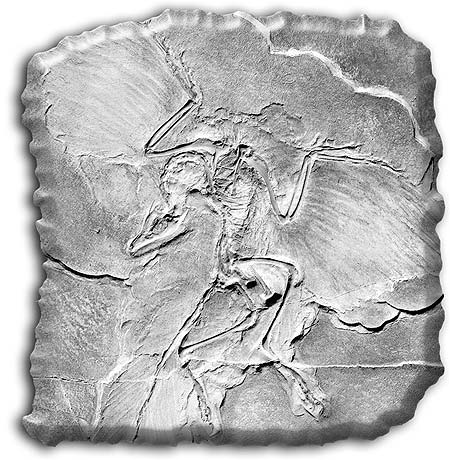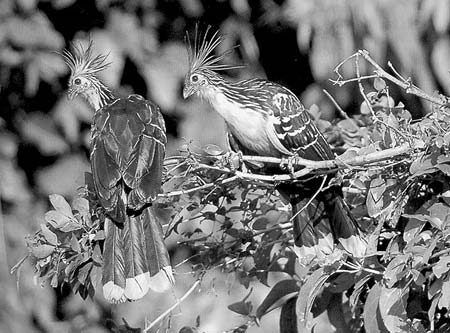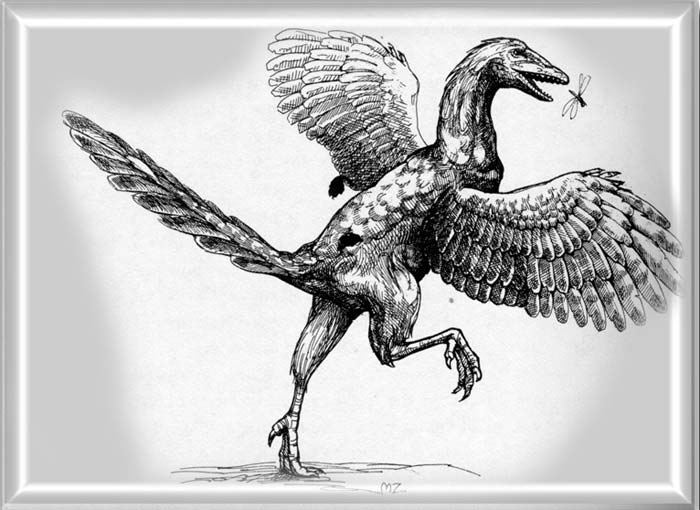Bigotry: The Dark Danger
Confessions of the Evolutionists

DOWNLOAD THE BOOK
CHAPTERS OF THE BOOK
- Introduction
- Chapter 1. Charles Darwin's Confessions Regarding His Theory
- Chapter 2. Evolutionists' Confessions Regarding Darwin
- Chapter 3. Evolutionists' Confessions Regarding the Invalidity of the Theory of Evolution
- Chapter 4. Evolutionists' Confessions Stating that They Espouse the Theory of Evolution for Ideological Reasons
- Chapter 5. Evolutionists' Confessions Stating that Natural Selection has No Evolutionary Power
- Chapter 6. Evolutionists' Confessions Stating that Mutations Have No Evolutionary Power
- Chapter 7. Evolutionists' Confessions Regarding the Dead-End of Molecular Evolution
- Chapter 8. Evolutionists' Confessions Regarding the Sudden Emergence of Life
- Chapter 9. Evolutionists' Confessions Regarding the Lack of Intermediate-Form Fossils
- Chapter 10. Evolutionists' Confessions Stating that There Is No Evidence of a Transition from Invertebrates to Vertebrates
- Chapter 11. Evolutionists' Confessions of the Impossibility of a Transition from Water to Dry Land
- Chapter 12. Evolutionists' Confessions of the Impossibility of Reptiles Evolving into Birds
- Chapter 13. Evolutionists' Confessions Stating That the Theory of Evolution Cannot Account for the Origin of Mammals
- Chapter 14. Evolutionists' Confessions Regarding the Invalidity of the "Horse Series"
- Chapter 15. Evolutionists' Confessions Regarding the So-Called Forebears of Man
- Chapter 16. Evolutionists' Confessions Stating that the Human Soul cannot Be Explained in Terms of Evolution
- Chapter 17. Evolutionists' Confessions Stating that Complex Organs cannot Appear by Way of Evolution
- Chapter 18. Evolutionists' Confessions Stating that the Theory of Evolution cannot Explain Animal Instincts
- Chapter 19. Evolutionists' Confessions Stating that Plants Cannot have Arisen by Way of Evolution
- Chapter 20. Evolutionists' Confessions Regarding Variations
- Chapter 21. Evolutionists' Confessions Stating the Non-existence of Vestigial Organs
- Chapter 22. Evolutionists' Confessions Regarding the Invalidity of the Claims of Homology
- Chapter 23. Evolutionists' Confessions Stating that the Evolution Theory Violates the Second Law of Thermodynamics
- Chapter 24. Evolutionists' Confessions Regarding the Invalidity of the Theory of Recapitulation
- Chapter 25. Evolutionists' Confessions Stating that Life Can Only Have Been Created
- Chapter 26. Materialists' Confessions Stating that the Universe Has a Beginning
- Chapter 27. Evolutionists' Confessions Stating that the Order in the Universe Cannot Have Come about by Chance
- Chapter 28. Evolutionists' Confessions Regarding Darwinism's Negative Effect on Moral Values
- Conclusion
< <
13 / total: 30
Chapter 12. Evolutionists' Confessions of the Impossibility of Reptiles Evolving into BirdsThe impossible scenarios of evolution also require the life forms that emerged onto dry land, first evolved into amphibians, then reptiles and finally turned into flying creatures. Since evolutionists are convinced that birds had to have evolved in some way, they maintain that they evolved from reptiles. But none of the physical mechanisms in birds-which have a totally different anatomy from that of terrestrial life forms-can be explained in terms of the gradual evolutionary model. First of all, birds' wings, and moreover even one single feather in these wings, represent an enormous dilemma for the theory of evolution. Evolutionists themselves state the impossibility of a reptile ever being able to fly, admitting that the idea conflicts with the fossil record. William Elgin Swinton is an emeritus professor of zoology at the University of Toronto and dinosaur expert of the Natural History Museum in London:
Alan Feduccia is professor of avian evolution, paleobiology and systematics at the University of North Carolina:
Evolutionist John E. Hill and James D. Smith are the authors of Bats - A Natural History:
Robert L. Carroll is a vertebrate paleontologist:
Evolutionists' Confessions Stating the Impossibility of Reptilian Scales turning into Bird FeathersEvolutionists maintain that reptile scales gradually turned into bird feathers by way of mutations and natural selection. However, as evolutionists themselves admit, this is anatomically and physiologically impossible, because reptile scales and bird feathers have totally different structures. A. H. Brush is Professor of Physiology and Neurobiology at the University of Connecticut:
Alan Feduccia is a famous ornithologist at University of North Carolina:
Barbara J. Stahl is an evolutionist paleontology professor and senior faculty member at Saint Anselm College, Manchester:
Evolutionists' Confessions About the Supposed Intermediate Form Archaeopteryx
Asked why there are no semi-winged or half-winged fossils, evolutionists refer to one life form in particular: the fossil known as Archaeopteryx, the best known of the small number of supposed intermediate forms all of which are invalid, so fiercely espoused by evolutionists. According to their thesis, Archaeopteryx, the forerunner of present-day birds, lived around 150 million years ago and was a semi-bird possessing various reptilian characteristics. This unlikely tale is repeated in just about every evolutionist publication. The fact is, however, that the latest researches into Archaeopteryx fossils have shown that the creature was very definitely not any intermediate form, merely a highly perfect structured extinct species of bird with some features slightly different from those of present-day birds. The evidence that Archaeopteryx was a true bird and not a semi-dinosaur, semi-bird transitional form can be summarized as follows: 1. The fact that it had no sternum, or breastbone, with the same structure as that in today’s flying birds was depicted as the most important evidence that Archaeopteryx could not fly. But the seventh Archaeopteryx fossil to be discovered in 1992 provoked enormous astonishment among evolutionist circles, because it did indeed possess a sternum of the kind evolutionists had for long failed to believe in. Nature magazine said, "This attests to its strong flight muscles."244 This discovery totally invalidated the most fundamental basis for the claim that Archaeopteryx was a proto-bird lacking the full ability to fly. It has been realized that Archaeopteryx was a perfect species of bird that could fly 150 million years ago. 2. On the other hand, one of the main proofs that Archaeopteryx was genuinely capable of flight is the animal's asymmetrical feather structure, identical to that in present-day birds, showing that it was able to fly perfectly. 3. Features that evolutionists rely on when portraying Archaeopteryx as an intermediate form are the claws on its wings and the teeth in its mouth. However, these features do not demonstrate that it was connected to reptiles in any way. Two living species of birds, the Taouraco and Hoatzin, also have claws that allow them to cling to branches. Yet they are fully fledged birds, with no reptilian characteristics whatsoever. Therefore, the idea that Archaeopteryx was an intermediate form because of its clawed wings is totally invalid. The Archaeopteryx FossilNor do the teeth in Archaeopteryx's mouth make it a transitional form. In stating that its teeth are a reptilian characteristic, evolutionists are engaging in deliberate deception. Teeth are not a universal feature among reptiles. Some present-day reptiles lack teeth. The fossil record shows that there was another group that may be described as toothed birds that lived in the same period as Archaeopteryx, and even before and after it-indeed, until quite recent times. Even more importantly, the tooth structure of Archaeopteryx and that of other toothed birds is very different from that of dinosaurs, birds' supposed evolutionary ancestors. Archaeopteryx and Other Ancient Bird FossilsIn 1995, two paleontologists by the names of Lianhai Hou and Zhonghe Zhou, researching at the Vertebrate Paleontology Institute in China, discovered a new bird fossil they named Confuciusornis. This bird, the same age as Archaeopteryx, had no teeth, but its beak and feathers exhibited the same features as present-day birds. The wings of this creature, whose skeleton was also the same as that of present-day birds, had claws. Hoatzin
Another fossil, discovered in China in November 1996, provoked yet more controversy. The existence of this 130-million-year-old bird, called Liaoningornis, was announced by Hou, Martin and Alan Feduccia in a paper published in Science magazine. This creature was identical to present-day birds in all respects, and yet was a contemporary of Archaeopteryx. The only difference was the absence of teeth in its mouth. This went to show that, in contrast to evolutionist claims, toothed birds were in no way "primitive." Another fossil that totally discredited evolutionist claim regarding Archaeopteryx was Eoalulavis. This animal was said to be 30 million years younger than Archaeopteryx-in other words, around 120 million years old-and its wing structure can still be seen in slow-flying birds today. This proved that living things, no different in many ways to present-day birds, were flying in the skies 120 million years ago. These data proved beyond the shadow of a doubt that Archaeopteryx and other birds resembling it were not intermediate forms. These fossils did not demonstrate that different species of bird evolved from one another. On the contrary, they proved that various independent bird species not unlike Archaeopteryx and those alive today lived alongside one another. In fact, the majority of evolutionists are well aware that Archaeopteryx cannot be an intermediate form, and that is simply an extinct species of bird.
The evolutionist magazine Nature described how, with every new Archaeopteryx fossil discovery, it was realized that the animal cannot have been half-bird and half-reptile, still unable to fly, but that on the contrary it was a fully flying bird:
Alan Feduccia:
John H. Ostrom is Professor of Geology Chair at Yale University:
John H. Ostrom from Yale University, who actively studied specimens, has said that it is evident that we now need to look to periods porior to Archaeopteryx in order to seek the ancestor of flying birds. From Science magazine:
Carl O. Dunbar is professor of paleontology and stratigraphy at Yale University:
Larry Martin is an American vertebrate paleontologist and curator of the Natural History Museum and Biodiversity Research Center at the University of Kansas:
Nicholas Hotton is an American paleontologist at the University of Chicago:
Richard L. Deem is an American biologist at the University of Southern California:
Evolutionists Also Admit That They Cannot Account for the Origin of FliesIn maintaining that in their supposition dinosaurs turned into birds, evolutionists suggest that some dinosaurs beat their forearms together in order to catch flies, eventually grew wings and took to the air. This theory is devoid of any scientific foundation and is merely a product of the imagination. But it also contains a logical vicious circle. Because the insect that evolutionists cite in order to explain the origin of flight was already able to fly to perfection! An Example of Evolutionist Scenarios: Dinosaurs that Suddenly Developed Wings as They Chased after FliesHumans are unable to rise and lower their arms even ten times a second, yet some flies are capable of beating their wings 1,000 times a second. They also beat both their wings simultaneously. Even the slightest lag in one wing would impair the fly's balance, but such an event never occurs. Evolutionists should account for how the perfect flying ability in flies emerged, rather than coming up with scenarios about how flies induced a much clumsier life form-the reptile-to be able to fly. Robin Wootton, an evolutionist British biologist, admits the signs of the sublime Creation in the fly and sets out the dilemmas inherent in the question:
Pierre Paul Grassé is the former president of the French Academy of Sciences and author of the book Evolution of Living Organisms:
Footnotes234- W.E. Swinton, "The Origin of Birds," Biology and Comparative Physiology of Birds, editor A.J. Marshall, New York: Academic Press, 1960, Vol. 1, Chapter 1, p. 1, 235- Alan Feduccia, "Jurassic Bird Challenges Origin Theories," Geotimes, January 1996, p. 7. 236- John E. Hill-James D. Smith, Bats: A Natural History, London: British Museum of Natural History, 1984, p. 33. 237- Robert L. Carroll, Vertebrate Paleontology and Evolution, p. 336. 238- Ann Gibbons, "Plucking the Feathered Dinosaur,: Science, Vvol. 278, No. 5341, 14 November 1997, pp. 1229-30. 239- A.H. Brush, "On the Origin of Feathers," Journal of Evolutionary Biology, Vol. 9, 1996, pp. 131-133. 240- Douglas Palmer, "Learning to Fly," Review of The Origin of and Evolution of Birds by Alan Feduccia (Yale University Press, 1996) in New Scientist, Vol. 153, March 1, 1997, p. 44. 241- Alan Feduccia, "On Why Dinosaurs Lacked Feathers," The Beginning of Birds, Eichstatt, West Germany: Jura Museum, 1985, p. 76. 242- Barbara J. Stahl, Vertebrate History: Problems in Evolution, Dover, 1985, pp. 349-350. 243- Ibid. 244- Nature, Vol. 382, August, 1, 1996, p. 401. 245- S. J. Gould and N. Eldredge, Paleobiology, Vol. 3, 1977, p. 147. 246- Nature, Vol. 382, August, 1, 1996, p. 401. 247- Storrs L. Olson, Alan Feduccia, "Flight Capability and the Pectoral Girdle of Archæopteryx, Nature, No. 278, 15 March 1979, p. 248. 248- A. Feduccia and H.B. Tordoff, in Science, 203 (1979), p. 1020. 249- Pat Shipman, "Birds Do It... Did Dinosaurs?," New Scientist, 1 February 1997, p. 28. 250- John Ostrom, "Bird Flight: How Did It Begin?", American Scientist, January-February 1979, Vol. 67, p. 47. 251- The Oldest Fossil Bird: A Rival for Archæopteryx," Science, Vol. 199, 20 January 1978, p. 284. 252- J. Marx, "The Oldest Fossil Bird: A Rival for Archaeopteryx?" Science, 199 (1978), p. 284. 253- Carl O. Dunbar, Historical Geology, New York: John Wiley and Sons, 1961, p. 310. 254- Pat Shipman, "Birds Do It . . . Did Dinosaurs?," New Scientist, p. 28. 255- "Paleontology: Fossil Revisionism," Science, October 1986, p. 85; Scientific American, September 1986, p. 70. 256- Richard L. Deem, "Demise of the 'Birds are Dinosaurs' Theory," http://www.direct.ca/trinity/dinobird.html 257- J. Robin Wootton, "The Mechanical Design of Insect Wings," Scientific American, Vol. 263, November 1990, p. 120. 258- Pierre-P Grassé, Evolution of Living Organisms, New York: Academic Press, 1977, p. 30.
|
13 / total 30
You can read Harun Yahya's book Confessions of the Evolutionists online, share it on social networks such as Facebook and Twitter, download it to your computer, use it in your homework and theses, and publish, copy or reproduce it on your own web sites or blogs without paying any copyright fee, so long as you acknowledge this site as the reference.




